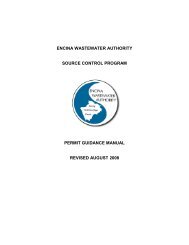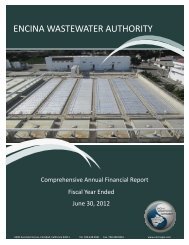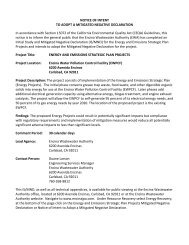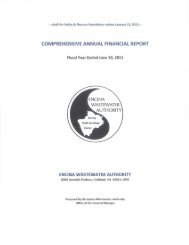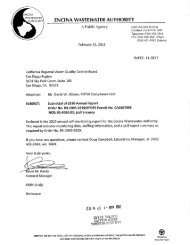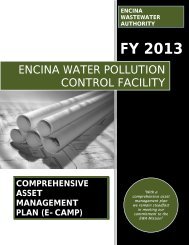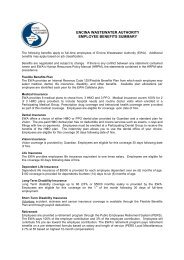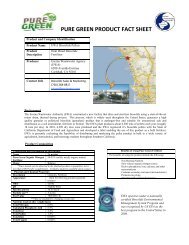biosolids ems internal audit report - Encina Wastewater Authority
biosolids ems internal audit report - Encina Wastewater Authority
biosolids ems internal audit report - Encina Wastewater Authority
Create successful ePaper yourself
Turn your PDF publications into a flip-book with our unique Google optimized e-Paper software.
<strong>Encina</strong> <strong>Wastewater</strong> <strong>Authority</strong><br />
BIOSOLIDS EMS INTERNAL AUDIT REPORT<br />
Audit Dates: March - May 2012<br />
Audit Conducted by:<br />
Celeste Biles, Industrial Waste Control Inspector<br />
Doug Campbell, Laboratory Manager<br />
Joe Cipollini, Shift Supervisor<br />
Will Harris, Operator<br />
Justin Law, Associate Chemist<br />
Kevin Smith, Maintenance Planner<br />
Leeann Warchol, Administrative Services Manager<br />
Audit Report Date: July 20, 2012<br />
Audit Report Prepared by:<br />
Debbie Biggs, EMS Coordinator<br />
Doug Campbell, Laboratory Manager
<strong>Encina</strong> <strong>Wastewater</strong> <strong>Authority</strong><br />
BIOSOLIDS EMS INTERNAL AUDIT REPORT<br />
Table of Contents<br />
I. EXECUTIVE SUMMARY.….………………………………..………………....3<br />
II. AUDIT SCOPE AND METHODOLOGY………………………………….…..3<br />
III. SUMMARY OF AUDIT FINDINGS……………………………..………..……4<br />
A. EMS Strengths……………………..……………………………….….…...4<br />
B. Findings Needing Correction...…………………………….….….….…...4<br />
C. Opportunities for Improvement…………………..………….…..………...4<br />
IV. AUDIT DETAILS………………………………...…………………….…..........5<br />
A. <strong>Wastewater</strong> Treatment/Solids Generation/Solids Stabilization…..........5<br />
B. Storage/Transportation………………………………..……….....…..……7<br />
C. Beneficial Reuse…………………………………………………..….…….8<br />
D. Pretreatment………………………………………………….…..……......10<br />
E. Laboratory…………………………………………………...……………..11<br />
F. Information Technology……………………………………..……....…....13<br />
G. Management……………………………….………………….…………...14<br />
H. EMS Awareness………………………………………….…..……………15<br />
V. AUDIT CONCLUSIONS…………………………….…………….……….….16<br />
A. Conformance with EWA’s Biosolids Management Policy…….…....…16<br />
B. Conformance with NBP Code of Good Practice……….……...........…16<br />
C. Achievement of Biosolids Program Goals & Objectives……..…..……19<br />
2
I. EXECUTIVE SUMMARY<br />
The <strong>Encina</strong> <strong>Wastewater</strong> <strong>Authority</strong> (EWA) conducted an <strong>internal</strong> <strong>audit</strong> of its<br />
Biosolids Environmental Management System (EMS) between March and May of<br />
2012. The purpose of the <strong>audit</strong> was to determine if EWA is complying with its<br />
Biosolids Management Policy, the National Biosolids Partnership (NBP) Code of<br />
Good Practice, and program requirements as found in EWA’s EMS Manual. The<br />
<strong>audit</strong> was conducted in accordance with protocol developed by EWA and<br />
covered the entire <strong>biosolids</strong> value chain including wastewater treatment, solids<br />
generation and stabilization, <strong>biosolids</strong> storage and transportation, beneficial<br />
reuse and pretreatment, as well as laboratory operations, information technology<br />
and management.<br />
The <strong>audit</strong> identified four strengths in EWA’s EMS program, one it<strong>ems</strong> needing<br />
correction, and five opportunities for improvement. Corrective action plans have<br />
been developed for the it<strong>ems</strong> needing correction. The opportunities for<br />
improvement will be considered during the annual Management Review meeting.<br />
Based on the results of the <strong>audit</strong>, EWA’s EMS Coordinator finds that the<br />
agency’s Biosolids EMS complies with its Biosolids Management Policy, the NBP<br />
Code of Good Practice and EWA’s program requirements. EWA continues to<br />
make progress in accomplishing its goals and objectives, and is achieving<br />
positive outcomes in the areas of regulatory compliance, environmental<br />
performance, relations with interested parties and quality <strong>biosolids</strong> practices. As<br />
a result, EWA’s Biosolids EMS is considered to be an effective program.<br />
II.<br />
AUDIT SCOPE AND METHODOLOGY<br />
The <strong>internal</strong> <strong>audit</strong> was conducted in accordance with protocol developed by<br />
EWA, which has been deemed a “best practice” by EWA’s third-party <strong>audit</strong>or.<br />
The <strong>audit</strong> team consisted of eight staff members selected by EWA’s EMS<br />
Coordinator. These individuals were chosen based on their knowledge of the<br />
organization and/or their ability to gather and analyze objective evidence.<br />
The <strong>audit</strong> covered the elements of the <strong>biosolids</strong> value chain, as well as laboratory<br />
operations, information technology and management. Assignments were made<br />
so that no one <strong>audit</strong>ed <strong>biosolids</strong> activities within their workgroup. The following<br />
list identifies the areas <strong>audit</strong>ed and assigned <strong>audit</strong>ors.<br />
Area Audited<br />
<strong>Wastewater</strong> Treatment/Solids Generation/<br />
Solids Stabilization<br />
Storage/Transportation<br />
Beneficial Reuse<br />
Pretreatment<br />
Laboratory<br />
Information Technology<br />
Management<br />
Audit Team Members<br />
Celeste Biles\Justin Law<br />
Celeste Biles\Kevin Smith<br />
Leeann Warchol\Will Harris<br />
Leeann Warchol\Joe Cipollini<br />
Kevin Smith\Will Harris<br />
Justin Law\Joe Cipollini<br />
Doug Campbell<br />
3
The individual <strong>audit</strong>s consisted of interviews with EWA staff members working in<br />
each area and a review of applicable records. Audit questions were developed<br />
by the EMS Coordinator to address EMS awareness, as well as departmentspecific<br />
issues, including areas of concern identified by the Management Review,<br />
third-party <strong>audit</strong>, or previous <strong>internal</strong> <strong>audit</strong>s.<br />
In addition to the aforementioned <strong>audit</strong>s, EWA regularly inspects its <strong>biosolids</strong><br />
contractors. During the last twelve months, EWA staff visited the CEMEX<br />
cement kiln that utilizes EWA’s <strong>biosolids</strong> as a biofuel and one Terra Renewal’s<br />
land application sites. The results of these inspections have been incorporated<br />
into the assessment of EWA’s transportation and beneficial reuse processes.<br />
III.<br />
SUMMARY OF AUDIT FINDINGS<br />
The <strong>internal</strong> <strong>audit</strong> identified a number of strengths in EWA’s Biosolids EMS<br />
program, one finding needing correction and five opportunities for improvement,<br />
which are summarized below. Corrective action plans have been developed for<br />
the it<strong>ems</strong> needing correction. The opportunities for improvement will be<br />
evaluated during the annual Management Review meeting.<br />
A. EMS Strengths<br />
1. Use of multiple employee committees is enhancing EWA’s ability to meet<br />
Biosolid Management Goals and EMS program directives.<br />
2. EWA’s pellet product quality became more consistent due to operational<br />
adjustments in 2011, enhancing marketability.<br />
3. Interagency communication, training and positive relations are helping<br />
EWA fulfill its mission of to protecting the Pacific Ocean and enhancing its<br />
ability for resource recovery.<br />
4. EWA is proactively conducting condition assessments of underground<br />
infrastructure to prevent catastrophic failures.<br />
B. Findings Needing Correction<br />
1. Vendors performing research or studies onsite should go through formal<br />
safety training and facility orientation. Staff contact and emergency contact<br />
information should be shared by both parties to reduce risk. Training<br />
documentation should be maintained.<br />
C. Opportunities for Improvement<br />
1. Sodium hypochlorite and ferric chloride vendors should be added to the<br />
chemical section of the emergency phone list.<br />
2. A semiannual review of the Emergency Phone List should be entered into<br />
MUNIS to help ensure it is up-to-date.<br />
4
3. A Dust Control SOP for the heat dryer building will help ensure continued<br />
implementation of current practices, which help provide a safe work<br />
environment for staff.<br />
4. Development of an <strong>internal</strong> policy will provide guidance to staff on training<br />
and work assignments.<br />
5. Organization of all of EWA’s SOPs should be evaluated to ensure they are<br />
readily available to appropriate staff.<br />
IV.<br />
AUDIT DETAILS<br />
A. <strong>Wastewater</strong> Treatment/Solids Generation/Solids Stabilization<br />
This <strong>audit</strong> was conducted on April 12 and May 7, 2012 by Celeste Biles and<br />
Justin Law. EWA staff members interviewed were: Shift Supervisor Fran<br />
Deleonardis, Operator Jimmy Madrigal, Maintenance Manager John Fetu and<br />
Maintenance Technician Jim English.<br />
Records reviewed include:<br />
Odor complaint <strong>report</strong>s, (2 in 2011; 5 in 2010)<br />
Training records,<br />
Daily checksheets & Master log,<br />
Heat dryer checksheets,<br />
Raceway Pump Station checksheets,<br />
Chemical spill <strong>report</strong>s,<br />
Emergency phone list,<br />
Operations department schedule,<br />
Unknown substance <strong>report</strong>s,<br />
Chemical delivery log,<br />
Biosolids hauling log,<br />
Fuel usage log for engines,<br />
Employee training records,<br />
Flow meter calibration records,<br />
pH meter calibration records,<br />
Thermocouple calibration records,<br />
Dissolved oxygen probe maintenance records,<br />
Cogen gas meter calibration records,<br />
Central vacuum maintenance records,<br />
CMMS scheduled maintenance tasks,<br />
SOP #2 – Odor Complaints,<br />
SOP #18 – Bulk Chemical Handling Procedure,<br />
SOP #19 – Biosolids Guidelines Reuse Compliance<br />
SOP #56 – Raceway Pump Station standard operating procedure, and<br />
SOP #44 – Spill Reporting Procedures.<br />
5
The following operational controls were verified during the <strong>audit</strong>:<br />
Staff was knowledgeable of the requirements for <strong>biosolids</strong> to meet both<br />
Class B and Class A standards. A review of heat dryer checksheets<br />
showed that the exit temperature averages >200˚F, well above the<br />
minimum requirement of 176˚F for Class A. Class B requirements were<br />
also maintained with the following information being verified, 95-98 O F<br />
digester temperature, 15 day minimum retention and 38% reduction of<br />
volatile solids.<br />
SOP #2 contains procedures for investigating odor complaints. A review<br />
of the two complaint <strong>report</strong>s from 2011 showed that they were properly<br />
completed. The investigation procedure includes documentation of<br />
weather conditions. The recent procurement of an onsite weather station<br />
will provide more accurate information about weather impacts.<br />
Additionally, an Air Quality Committee has been formed that meets<br />
quarterly to address odor issues. (See Section III.A.1. EMS Strengths)<br />
SOP #18 contains procedures for dealing with chemical spills. An incident<br />
<strong>report</strong> is completed for such occurrences and an investigation is<br />
conducted to identify the cause(s) and ways to prevent a recurrence. An<br />
investigation of a 10/7/2011 sodium hypochlorite spill that was caused by<br />
a structural failure of the drain revealed that the containment structure had<br />
some cracks. The structure was repaired and tested, and the tank<br />
replaced.<br />
EWA has an SOP for operation and maintenance of each pump station<br />
that staff has responsibility for. A review of checksheets for the Raceway<br />
Pump Station showed that required activities are being completed.<br />
Our contracts with chemical suppliers state that if they cannot provide a<br />
chemical delivery, they are responsible for paying any cost difference for<br />
us to get it from another supplier. Phone numbers for backup suppliers of<br />
polymer, nitrogen and biodiesel are included on EWA’s emergency phone<br />
list. Alternate suppliers of sodium hypochlorite and ferric chloride should<br />
also be added to the chemical section of the emergency phone list. (See<br />
Section III.C.1. Opportunities for Improvement)<br />
An in-house Heat Dryer Operations Committee meets quarterly to discuss<br />
product quality and heat dryer optimization. As a result of their efforts,<br />
operational changes have been made, resulting in a more consistent<br />
product and enhancing marketability. (See Section III.A.1and 2. EMS<br />
Strengths)<br />
The Operations Department hosted a Heat Dryer Forum in December<br />
2011 to share lessons learned from start-up of new facilities. The meeting<br />
was attended by three agencies that operate a heat dryer or will be<br />
installing one in the future.<br />
As required by the State of California, EWA’s Chief Plant Operator holds a<br />
Grade V operator certification. EWA requires that Shift Supervisors have<br />
at least a Grade III certification. A review of the current schedule showed<br />
that there is always at least a Grade III operator onsite.<br />
The use of digester gas and natural gas is limited by EWA’s air permits.<br />
This information is recorded in the operations daily logbook and<br />
6
transferred to the Flows & Monthly Reports spreadsheet. A review of<br />
sample data showed that information is being properly recorded.<br />
A Dust Mitigation Committee was formed to address safety concerns<br />
related to the heat dryer facility. Staff has developed a regular cleaning<br />
and maintenance schedule including logging of vacuum run hours and<br />
maintaining photographic documentation. Development of a Dust Control<br />
SOP would ensure continued implementation of these procedures. (See<br />
Section III.C.3. Opportunities for Improvement )<br />
<br />
Professional Qualification Standards documentation was reviewed for both<br />
operations and maintenance, which demonstrates the comprehensive<br />
training provided to new employees. Currently there are three staff<br />
members from General Services and one from Operations enrolled. No<br />
policy has been developed for new interns. (See Section III.C.4.<br />
Opportunities for Improvement )<br />
A review of records showed that all flow meters used to determine influent<br />
and effluent flow were calibrated in the last year.<br />
Preventative maintenance pit stops have improved the efficiency of the<br />
heat dryer maintenance.<br />
Validated that the UPS circuits in cogeneration were updated during FY<br />
2012 in response to the October 2010 SDG&E power outage and lack of<br />
ability to black start.<br />
During 2011, 5,316 work orders were completed by the General Services<br />
department. Of these, 74% were planned or preventive maintenance<br />
tasks.<br />
B. Storage/Transportation<br />
This <strong>audit</strong> was conducted on March 29, 2012 by Kevin Smith and Celeste Biles.<br />
Shift Supervisor Joe Cipollini and Operator Nick Lalonde were interviewed.<br />
Records reviewed include:<br />
<br />
<br />
<br />
<br />
<br />
<br />
<br />
<br />
<br />
<br />
<br />
<br />
Recycle bin/storage silo checksheet,<br />
Trailer inspection checksheets,<br />
Biosolids hauling manifests,<br />
Biosolids hauling and trailer return <strong>report</strong>s,<br />
Driver training records and training on spill reponse,<br />
Employee respirator training and fit test records,<br />
Employee hearing conservation training and audiogram records,<br />
SOP #07 – Contractor Biosolids Hauling,<br />
SOP #20 – Emergency Storage of Digested Sludge,<br />
SOP #32 – Biosolids Spill Response Plan,<br />
SOP #62 – Heat Dryer System Operation,<br />
SOP #64 – Biosolid Loading Procedures.<br />
7
The following operational controls were verified during the <strong>audit</strong>:<br />
Pellet heating and smoldering events have been reduced by taking a more<br />
proactive approach to mitigating probl<strong>ems</strong> before heating occurs. Based<br />
on information obtained from visiting another heat drying facility, EWA<br />
conducted a test where the silos were continuously purged with nitrogen,<br />
which enabled pellets to be stored for seven days.<br />
EWA maintains two backup trailers onsite, which provide for additional<br />
pellet storage. In case of an emergency, an offline digester could also be<br />
used to store digested sludge.<br />
An in-house modification to the centrifuges has extended the life span of<br />
the stators saving money, operational down time and maintenance costs.<br />
Operations staff conducts inspections of contractor’s trailers prior to<br />
leaving the site to ensure they are in good condition, which is documented<br />
on checksheets.<br />
Personal protective equipment (PPE) requirements for <strong>biosolids</strong> handling<br />
include wearing hearing protection in the dryer building, and a Tyvek suit<br />
and respirator when loading <strong>biosolids</strong>. A review of records showed that all<br />
O&M staff has completed the required hearing/respirator training.<br />
An automated system was installed by the nitrogen vendor to signal them<br />
when the nitrogen level reaches 50%, which should initiate delivery within<br />
48 hours.<br />
Terra Renewal’s contract requires that all <strong>biosolids</strong> hauling trucks carry a<br />
copy of their emergency response plan. During the <strong>audit</strong>, a copy of the<br />
plan was produced by both Apex’s and Terra Renewal’s drivers.<br />
EWA’s contract with Terra Renewal requires them to provide driver<br />
training on emergency response procedures. In 2011 EWA began training<br />
drivers and keeping records in response to Terra Renewal’s lack of follow<br />
through on training efforts.<br />
Non-hazardous material manifests are completed for each load of<br />
<strong>biosolids</strong> hauled. A review of records showed that completed manifests<br />
matched the weight on the invoice from Apex.<br />
C. Beneficial Reuse<br />
This <strong>audit</strong> was conducted at the EWPCF on May 3, 2012 by LeeAnn Warchol<br />
and Will Harris, who interviewed EWA Resource Recovery Manager Octavio<br />
Navarrete and Miguel Gutierrez. Also incorporated in this process <strong>audit</strong> were the<br />
findings of site visits to CEMEX and two of Terra Renewal’s land application<br />
sites.<br />
Records reviewed include:<br />
Heat dryer data sheet,<br />
Biosolids feedback information,<br />
2011 Annual Biosolids Report<br />
Contractor inspection <strong>report</strong>s,<br />
Ostara Struvite Recovery System proposal,<br />
8
Terra Renewal’s monthly <strong>biosolids</strong> <strong>report</strong>,<br />
Lab data for <strong>biosolids</strong> cake and pellets,<br />
Biosolids hauling manifests,<br />
Fertilizer registration renewal,<br />
Biosolids fertilizer label, and<br />
Terra Renewal insurance information.<br />
The following operational controls were verified during the <strong>audit</strong>:<br />
Communication with both CEMEX and Terra Renewal remain challenging.<br />
The contracts specify various requirements in regards to billing (CEMEX)<br />
and hauling needs (Terra) that are not always followed. Continued<br />
implementation of EWA’s Biosolid Management Plan may reduce the<br />
need for their services.<br />
Ostara provided EWA with a preliminary design and cost analysis for their<br />
struvite recovery process. The payback on this investment is very long,<br />
thus other options are being investigated.<br />
An inspection of CEMEX was conducted on November 22, 2011.<br />
Housekeeping in the <strong>biosolids</strong> use area was satisfactory. Air permits and<br />
employee training records were reviewed and found to be in order. There<br />
were no records of public complaints.<br />
<br />
EWA staff conducted inspections at one of Terra Renewal’s land<br />
application sites in Arizona (June 28, 2012). Housekeeping practices and<br />
public communication records were found to be acceptable.<br />
Terra Renewal provides <strong>report</strong>s to EWA for each month in which <strong>biosolids</strong><br />
are land applied. These <strong>report</strong>s include: the amount of <strong>biosolids</strong> applied<br />
to each field, field maps, lab analysis data and cumulative pollutant<br />
loadings for each field. A review of this information verified that they are in<br />
compliance with allowable agronomic rates.<br />
EWA provides bimonthly <strong>biosolids</strong> testing results to Terra Renewal<br />
including percent solids, arsenic, cadmium, copper, lead, mercury,<br />
molybdenum, nickel, selenium, zinc, total nitrogen, ammonia nitrogen,<br />
organic nitrogen and nitrate-nitrite nitrogen. A review of results show that<br />
metal levels in EWA’s <strong>biosolids</strong> are well below the ceiling concentrations<br />
found in Table 1 of 40 CFR Part 503.13, and are considered exceptional<br />
quality.<br />
<br />
Prior to being able to use <strong>biosolids</strong> as a fertilizer, the California<br />
Department of Food & Agriculture requires the material to be registered<br />
with the State. EWA completed this application and was issued a license<br />
on March 23, 2011. The Resource Recovery Manager completed the<br />
registration renewal 1/31/2012.<br />
Terra Renewal’s contract requires them to maintain general liability,<br />
automobile, worker’s compensation, pollution liability and environmental<br />
impairment insurance. A review of documentation showed that current<br />
policies are in effect.<br />
9
D. Pretreatment<br />
This <strong>audit</strong> was conducted on March 27, 2012 by LeeAnn Warchol and Joe<br />
Cipollini. EWA Industrial Waste Control Inspectors Celeste Biles and Stacey<br />
Spangler were interviewed.<br />
Records reviewed include:<br />
<br />
<br />
<br />
<br />
<br />
<br />
<br />
<br />
<br />
<br />
<br />
<br />
<br />
Pretreatment Ordinance,<br />
Review of monthly business license <strong>report</strong>,<br />
Significant Industrial User (SIU) permit,<br />
EWA Class I, II and III industrial user listing,<br />
Industry records in LINKO database,<br />
Industry self-monitoring <strong>report</strong>,<br />
Best Management Practices (BMP) industry list,<br />
SOP #1- <strong>Wastewater</strong> Sampling Procedures for Member Agencies,<br />
SOP #34 – Auto-sampler Maintenance,<br />
Sample chain-of-custody documentation,<br />
Enforcement Response Plan,<br />
Sample enforcement case, and<br />
Industry inspection form and BMP checksheet.<br />
The following operational controls were verified during the <strong>audit</strong>:<br />
EWA’s Pretreatment Ordinance gives the agency authority to implement<br />
the Pretreatment Program throughout the service area. This was recently<br />
updated on February 22, 2012 and became effective March 14, 2012. The<br />
updated ordinance can be found on EWA’s website. The revised<br />
Pretreatment Ordinance was approved by the Regional Water Quality<br />
Control Board in April 2012. All Significant Industrial User permits have<br />
been reissued to incorporate the revised local limits.<br />
EWA controls industrial discharges through the issuance of wastewater<br />
discharge permits. Permittees may be issued a Class I, II, or III permit<br />
depending on the nature of their discharge. Review of a sample permit<br />
showed that it contains information about the industry’s operations,<br />
sampling and <strong>report</strong>ing requirements, discharge limits and sampling<br />
location.<br />
To verify compliance, EWA conducts annual inspections of permitted<br />
industries and quarterly wastewater monitoring of Significant Industrial<br />
Users (SIUs – those subject to federal categorical pretreatment standards<br />
or that discharge >25,000 gallons per day). More frequent inspections<br />
and sampling are conducted in response to violations. A review of the<br />
LINKO database confirmed that the minimum inspection and sampling<br />
frequency is being met.<br />
A chain of custody (COC) form is completed for all wastewater samples<br />
collected. Review of a typical COC form showed that it was properly<br />
completed.<br />
10
pH meters are calibrated each day they are used. Review of the<br />
calibration log showed that this is being done as required using standards<br />
with a pH of 4, 7 and 10.<br />
SOP #34 contains maintenance procedures for auto-samplers to help<br />
prevent contamination of wastewater samples. This includes specific<br />
cleaning procedures, semiannual QA/QC testing for seven metals, and<br />
replacement of bottles and tubing as necessary. Review of the<br />
maintenance log showed that these activities are being conducted in<br />
accordance with the SOP. This SOP is numbered differently and not<br />
located with other department SOPs. (See Section III.C.5. Opportunities<br />
for Improvement )<br />
In response to an industry violation, the first step is issuance of a Notice of<br />
Violation (NOV) which requires the industry to: investigate the cause for<br />
the violation; take actions to prevent a recurrence; and submit a letter to<br />
EWA by a specific date describing their findings and resulting actions. A<br />
review of an industry file showed that they submitted their <strong>report</strong> by the<br />
due date shown in the NOV.<br />
EWA has an Enforcement Response Plan that describes actions that may<br />
be taken in response to noncompliance. Enforcement actions are<br />
escalated if violations continue. This document was last updated on<br />
February 2, 2011 and is available on EWA’s website.<br />
Interagency communication regarding slug discharges has been effective<br />
since EWA conducted Member Agency training on procedures for<br />
<strong>report</strong>ing and sampling of unknown substances in the collection system. In<br />
response to a <strong>report</strong> from the City of Vista regarding petroleum odors in<br />
the collection system, an investigation was conducted by EWA staff, which<br />
successfully identified the source. The business was issue a Notice of<br />
Violation and required to clean their clarifier (See Section III.A.3. EMS<br />
Strengths)<br />
Permitted industries must submit semiannual <strong>report</strong>s to EWA that contain<br />
lab data, a COC form, a Compliance Status Report cover sheet and<br />
certification statements. A sample <strong>report</strong> was reviewed, which showed<br />
that it contained all the required information. Review of data entered into<br />
the LINKO database was consistent with the industry <strong>report</strong>.<br />
EWA staff conducts public outreach at street fairs and other public events<br />
to reduce the discharge of pollutants from nonindustrial sources.<br />
Residents are encouraged not to flush unwanted medications, and instead<br />
to either take them to the San Diego County Sheriff’s office or render them<br />
unusable and throw them in the trash.<br />
E. Laboratory<br />
This <strong>audit</strong> was conducted on April 30, 2012 by Kevin Smith and Will Harris. EWA<br />
staff members interviewed were Chemists Rachael Morgan and Therese<br />
Littlefeather.<br />
Records reviewed include:<br />
<br />
Environmental Laboratory Accreditation Program (ELAP) certification,<br />
11
Lab proficiency testing results,<br />
EWA pellet log,<br />
Chain-of-custody documentation,<br />
Biosolids testing data,<br />
Balance calibration records,<br />
Glassware QC records,<br />
Thermometer calibration records,<br />
Bimonthly <strong>biosolids</strong> <strong>report</strong> (NANI – Notice and Necessary Information),<br />
and<br />
SOP #57 – Biosolids Sampling.<br />
The following operational controls were verified during the <strong>audit</strong>:<br />
EWA’s lab is certified by the State of California Department of Health<br />
Services ELAP. The current certificate was issued on 3/1/11 and expires<br />
2/28/13.<br />
As part of the ELAP program, staff must analyze performance evaluation<br />
samples each year to demonstrate proficiency for each test method that<br />
the lab is certified to test for. EWA last participated in this study in June<br />
2011 and passed 100% of the samples tested. Certified methods include<br />
fecal coliform and total solids, which are required to demonstrate <strong>biosolids</strong><br />
meet Class A standards.<br />
<br />
Lab staff was knowledgeable on the requirements to demonstrate<br />
compliance with Class A <strong>biosolids</strong> standards including: total solids >90%;<br />
fecal coliform 176˚F. A review of data confirmed EWA’s <strong>biosolids</strong> meet<br />
Class A standards.<br />
SOP #57 documents procedures for sampling <strong>biosolids</strong>, as well as the<br />
sampling frequency and type of analysis required. Sampling is conducted<br />
by lab and operations staff. A log is completed for individual pellet<br />
samples that are used to generate a composite sample. Review of the log<br />
showed that the monthly composites are collected within the allowed 14<br />
day period.<br />
Balances must be calibrated annually by a third-party and monthly inhouse<br />
using validated weights. A review of calibration records showed<br />
this activity is being completed as required.<br />
With the exceedences of EWPCF NPDES 6-month median performance<br />
goal in 2008 and 2010 operations has implemented a limit for 3WHP<br />
chlorine level not to exceed 5ppm. Lab staff checks the outfall chlorine<br />
meter once a day (weekdays) and the lab manager checks the data<br />
recorder weekly for outfall chlorine levels. VWD also dechlorinates<br />
Meadowlark WRF failsafe flow. If the failsafe levels are elevated and the<br />
3WHP levels are low the Lab Manager calls VWD staff to check the<br />
dechlorination system.<br />
Staff conducts semiannual calibrations and notes any variation from the<br />
certified thermometer reading. This variation is corrected for in future<br />
reads and noted on thermometer checksheets.<br />
12
Required equipment maintenance is scheduled in the LIMS as<br />
recommended by last year’s <strong>internal</strong> <strong>audit</strong>.<br />
When the heat dryer is running, operations collects a daily pellet sample<br />
and provides them to the laboratory staff for a monthly composite. This<br />
composite is tested for heat value (BTU) and % total solids as required by<br />
the CEMEX contract. The Lab Manager then provides the results to the<br />
Resource Recovery Manager for billing purposes.<br />
Oil and grease analysis results received from an outside lab are entered<br />
into the LIMS database. Review of sample data in the LIMS showed that<br />
it was correctly entered.<br />
Monthly flow <strong>report</strong>s and raw ADS flow data were matched. Laboratory<br />
staff interviewed did not know where the information was, but did know<br />
who to ask.<br />
2011 issues with failed CBOD and BOD analysis have not been solved. DI<br />
tanks are now replaced around every 40 days. In addition, the lab has<br />
increased the number of analyses to avoid <strong>report</strong>ing deficiencies.<br />
Lab staff posted new NPDES permit requirements next to the daily testing<br />
bench. VWD was e-mailed changes to sampling and testing requirements<br />
in the new permit. The Laboratory Manager also reviewed it with their<br />
Operations Superintendent.<br />
Routine lab results are entered into an Excel spreadsheet on the O: drive<br />
for use by operators. In case of an exceedence, notifications are made in<br />
person after a second verification test has occurred.<br />
F. Information Technology<br />
This <strong>audit</strong> was conducted on April 11, 2012 by Celeste Biles and Fran<br />
Deleonardis. EWA staff members interviewed were Syst<strong>ems</strong> Manager David<br />
Ummel and Syst<strong>ems</strong> Technician James Harris.<br />
Records reviewed include:<br />
<br />
<br />
<br />
<br />
<br />
<br />
<br />
<br />
Biosolids Management Policy,<br />
2011 Annual Biosolids Program Report,<br />
2011 <strong>internal</strong> <strong>audit</strong> <strong>report</strong>,<br />
2010 third-party <strong>audit</strong> <strong>report</strong>,<br />
EMS Manual,<br />
LIMS backup records,<br />
MIS Password Procedure, and<br />
EWA’s Site Security Procedure.<br />
The following operational controls were verified during the <strong>audit</strong>:<br />
EWA recently updated its website and incorporated the former standalone<br />
EMS website. Review of the website showed that it contains the<br />
Biosolids Management Policy, 2011 Annual Biosolids Program Report,<br />
2011 <strong>internal</strong> <strong>audit</strong> <strong>report</strong>, EMS Manual and FY 2012 goals.<br />
13
Laboratory data stored in the LIMS is incrementally backed up every 15<br />
minutes. Full back-ups are done weekly and monthly. Proof of these<br />
activities was confirmed.<br />
EWA’s MIS Password Procedure requires computer users to change their<br />
password at least quarterly. The system starts notifying users 15 days<br />
prior to the due date. After four months, users are locked out of the<br />
system if they do not modify their password.<br />
Thumb drives on the SCADA computers were disabled to protect the<br />
network. This is considered industry best practices to reduce tampering<br />
risk. Access is limited to IT personnel.<br />
EWA’s Site Security Procedure requires that door/gate codes be changed<br />
every six months and/or when an employee leaves EWA. A review of<br />
records showed that all department codes have been changed in the last<br />
year.<br />
The Technology Master Plan update committee has received RFPs from<br />
five vendors. FY 2013 contains capital funds for the Technology Master<br />
Plan update.<br />
The server room is secured by three sets of locked doors that have<br />
different keys. The doors remain locked when no one from IT is on site.<br />
There is no remote access to the servers.<br />
The IT group has developed and begun implementation of a plan to<br />
consolidate its servers. This change will benefit EWA through: reduced<br />
costs for hardware and support; lower energy costs; less heat output;<br />
reduced storage space; and improved disaster recovery time.<br />
The IT group keeps up with security measures by receiving e-mail<br />
newsletters from the Department of Homeland Security. Staff also attends<br />
conferences and is provided vendor sponsored training.<br />
G. Management<br />
This <strong>audit</strong> was conducted on April 19, 2012 by Doug Campbell. EWA staff<br />
members interviewed were Assistant General Manager Michael Steinlicht,<br />
Director of Environmental Compliance Debbie Biggs, Director of Operations John<br />
Jardin, Director of General Services and Engineering Manager Duane Larson.<br />
The following operational controls were verified during the <strong>audit</strong>:<br />
EWA obtains public input about its <strong>biosolids</strong> program through multiple<br />
avenues: questions through the EWA’s website; feedback from outreach<br />
programs; survey results from customers; input from the Board of<br />
Directors who are the public’s representatives; conference participation;<br />
and interaction with peers. EWA has developed a relationship with<br />
CSUSM utilizing graduate students as interns. This input is considered in<br />
the management review process.<br />
In response to two emergency projects during 2010, EWA is proactively<br />
assessing the condition of aging infrastructure. The influent channels were<br />
recently inspected and deemed in need of rehabilitation or replacement,<br />
and thus will be included in the influent junction structure design. The<br />
14
aeration airline was relined, with two other smaller airlines to follow. A<br />
condition of the primary and secondary effluent lines is scheduled for this<br />
fall. The E-CAMP captures other underground piping and structural<br />
evaluations to be performed in the near future. (See Section III.A.4. EMS<br />
Strengths)<br />
When outside organizations propose studies or research using the facility,<br />
the executive team reviews the proposals with the final approval coming<br />
from the General Manager. The executive team considers matters such as<br />
potential effects on plant processes, staff and <strong>biosolids</strong> quality; however,<br />
no formal safety orientation is conducted or emergency phone lists<br />
provided by EWA. (See Section III.B.1. EMS Findings needing Correction)<br />
Implementation of EWA’s Energy & Emissions Strategic Plan to-date has<br />
accomplished: lining the aeration air piping; evaluating other leaking air<br />
pipes; studying variable frequency drives (VFDs) for the use on the<br />
cogeneration engines; evaluating a waste to energy program; and using<br />
SDG&E’s energy efficiency program to evaluate equipment efficiency.<br />
EWA has completed an organizational risk assessment to identify the top<br />
five to six risks the agency faces. Contingency plans will be developed for<br />
the identified risks and appropriate it<strong>ems</strong> incorporated into the Tactical<br />
Plan.<br />
EWA has formed an <strong>internal</strong> <strong>biosolids</strong> marketing committee to help ensure<br />
EWA achieves its Biosolids Management Plan goals. Efforts are being<br />
made to increase Tier II marketing efforts, which provide a greater source<br />
of revenue. The committee has developed a product name “Pure Green”<br />
and is working on a marketing strategy. A logo is being finalized, which<br />
can then be trademarked. The Biosolids Management Plan is scheduled<br />
to be updated in 2015. (See Section III.A.1. EMS Strengths)<br />
An Air Quality Committee was formed to address odor issues. This<br />
committee conducts quarterly inspections to identify deficiencies for<br />
correction. In addition twelve SOPs have been modified to incorporate<br />
odor mitigation measures. (See Section III.A.1. EMS Strengths)<br />
H. EMS Awareness<br />
All interviewees were asked the same questions to assess overall EMS<br />
awareness. The following observations were made:<br />
Employees understand that the purpose of the EMS Program is to<br />
establish standard practices that help ensure <strong>biosolids</strong> quality.<br />
Staff cited numerous benefits to EWA from implementation of the EMS<br />
including: improved documentation, increased awareness about <strong>biosolids</strong><br />
and the role of different departments; identification of back-up plans; and<br />
national recognition.<br />
Specific changes that have been made as a result of the EMS include:<br />
adding the EMS to job descriptions; requiring a higher level of<br />
accountability for contractors; implementing additional security measures;<br />
and incorporating the EMS into public outreach activities.<br />
15
V. AUDIT CONCLUSIONS<br />
A. Conformance with EWA’S Biosolids Management Policy<br />
EWA’s <strong>biosolids</strong> practices conform with its Biosolids Management Policy as<br />
detailed below:<br />
1. Pursue sustainable <strong>biosolids</strong> reuse options that protect human health and<br />
environmental quality, are fiscally responsible and provide flexibility with<br />
respect to end use. – In December 2008, EWA brought online a new heat<br />
drying facility that produces Class A <strong>biosolids</strong> pellets and provides more<br />
options for beneficial reuse. Due to the reduction in volume of <strong>biosolids</strong><br />
produced, EWA’s budget for <strong>biosolids</strong> disposal has been reduced from<br />
just over $2 million dollars in FY 2008 to $202,000 in FY 2012. In<br />
addition, over $43,750 in revenue was generated during FY 2012 from<br />
selling the pellets for use as a biofuel and as a soil amendment.<br />
2. Follow the Code of Good Practices for <strong>biosolids</strong> developed by the National<br />
Biosolids Partnership. – See Section B below.<br />
3. Implement the <strong>Encina</strong> <strong>Wastewater</strong> <strong>Authority</strong>’s Biosolids Management<br />
Plan. – EWA’s Biosolids Management Plan, which was finalized in April<br />
2008, establishes a long-term strategy for marketing EWA’s <strong>biosolids</strong>.<br />
Plan goals include securing beneficial reuse outlets for 100% of the<br />
material within five years and disposal outlets for 200% of the material<br />
within two years. These goals were met in the first year. EWA currently<br />
has an agreement with CEMEX for utilizing the <strong>biosolids</strong> as a biofuel. In<br />
addition, 728 tons were utilized as a soil amendment during FY 2012.<br />
Backup plans include a contract with Terra Renewal, which hauls EWA’s<br />
<strong>biosolids</strong> to Yuma, Arizona for land application or to the Otay Landfill.<br />
B. Conformance with NBP Code of Good Practice<br />
EWA’s <strong>biosolids</strong> practices conform with the NBP Code of Good Practice as<br />
detailed below:<br />
1. Compliance: To commit to compliance with all applicable federal, state<br />
and local requirements regarding production at the wastewater treatment<br />
facility and management, transportation, storage, and use or disposal of<br />
<strong>biosolids</strong> away from the facility – This commitment is contained in EWA’s<br />
Biosolids Management Policy. Implementation was verified through a<br />
review of:<br />
Laboratory data,<br />
SOPs,<br />
Operations’ checksheets, and<br />
Contractor site inspections and records review.<br />
16
2. Product: To provide <strong>biosolids</strong> that meet the applicable standards for their<br />
intended use or disposal – This was confirmed through a review of:<br />
Laboratory data (metals, total solids, fecal coliform), and<br />
Heat dryer checksheets (dryer outlet temperature).<br />
3. Environmental Management System: To develop an EMS for <strong>biosolids</strong><br />
that includes a method of independent third-party verification to ensure<br />
effective on-going <strong>biosolids</strong> operations. – A reverification <strong>audit</strong> of EWA’s<br />
EMS was conducted in 2010 by KEMA-Registered Quality, Inc. No major<br />
nonconformances were found. All minor nonconformances identified<br />
were addressed through EWA’s corrective action procedure. The <strong>audit</strong><br />
verified that EWA’s <strong>biosolids</strong> program meets the expectations and<br />
requirements of the NBP.<br />
4. Quality Monitoring: To enhance the monitoring of <strong>biosolids</strong> production and<br />
management practices – The heat dryer temperature is continuously<br />
monitored by EWA’s SCADA system, which is equipped with alarms to<br />
notify operators if probl<strong>ems</strong> occur. Readings are also taken manually and<br />
recorded on checksheets every hour. Metal levels are monitored monthly,<br />
although 40 CFR Part 503 regulations only require bimonthly testing.<br />
Total solids and fecal coliform testing are performed monthly to confirm<br />
compliance with Class A requirements.<br />
5. Quality Practices: To require good housekeeping practices for <strong>biosolids</strong><br />
production, processing, transport, and storage, and during final use or<br />
disposal options. – EWA has monthly checksheets for the digester and<br />
dewatering areas that require certain housekeeping activities. A<br />
centralized vacuum system was installed in the heat dryer building to help<br />
control dust. Housekeeping has improved with the formation of the Dust<br />
Mitigation Committee (See Section III.A.4. EMS Strengths). Terra<br />
Renewal’s contract requires that trucks be tarped to prevent the release of<br />
<strong>biosolids</strong> during transportation and then washed prior to being used again.<br />
Biosolids are transported to CEMEX in enclosed trailers. Routine<br />
inspections of EWA’s land application sites and the CEMEX facility found<br />
general site conditions and housekeeping to be acceptable.<br />
6. Contingency & Emergency Response Plans: To develop response plans<br />
for unanticipated events such as inclement weather, spills, and equipment<br />
malfunctions – EWA has developed SOP #20 for emergency storage of<br />
digested sludge in case of an earthquake, severe weather or other<br />
unplanned event. Terra renewal has a spill response plan that addresses<br />
what drivers should do in case of a spill, and contains notification and spill<br />
clean-up procedures. Training was provided for EWA Member Agency<br />
staff regarding slug response procedures. The annual spill drill was<br />
performed at BVPS and included four of five member agencies. (See<br />
Section III.A.3. EMS Strengths)<br />
17
7. Sustainable Management Practices and Operations: To enhance the<br />
environment by committing to sustainable, environmentally acceptable<br />
<strong>biosolids</strong> management practices and operations through an EMS – This<br />
commitment is contained in EWA’s Biosolids Management Policy. During<br />
2011 and to-date in 2012, 100% of EWA’s <strong>biosolids</strong> were beneficially<br />
reused as a biofuel, a soil amendment or for land application on farm<br />
fields in Arizona. In addition, EWA maintained its EMS certification by<br />
completing a reverification <strong>audit</strong> in September 2010.<br />
8. Preventive Maintenance: To prepare and implement a plan for preventive<br />
maintenance for equipment used to manage <strong>biosolids</strong> and wastewater<br />
solids – Plant assets used for <strong>biosolids</strong> processing and treatment are<br />
managed through EWA’s Enterprise Resourse Planning or MUNIS.<br />
Preventive maintenance for each asset is regularly scheduled through the<br />
MUNIS to ensure operational reliability of the <strong>biosolids</strong> processing system.<br />
In addition, Operations staff has the ability to generate maintenance<br />
service requests when they determine an asset needs additional attention.<br />
Approximately 76% of work orders completed are for planned and<br />
preventive maintenance.<br />
9. Continual Improvement: To seek continual improvement in all aspects of<br />
<strong>biosolids</strong> management – This is demonstrated via EWA’s tactical planning<br />
process and progress on achieving its <strong>biosolids</strong>-related goals and<br />
objectives during fiscal year 2012. EWA developed a <strong>biosolids</strong> marketing<br />
committee that has been working on developing a a product name and<br />
marketing strategy. In addition, one staff member has been focusing fulltime<br />
on marketing efforts, which has produced positive results. During the<br />
first six months of 2012, 18.3% of EWA’s <strong>biosolids</strong> were used in Tier II<br />
markets. See Section C below.<br />
10. Communications: To provide methods of effective communication with<br />
gatekeepers, stakeholders, and interested citizens regarding the key<br />
elements of each EMS, including information relative to system<br />
performance – EWA maintains a website where it posts <strong>internal</strong> and<br />
external <strong>audit</strong> <strong>report</strong>s, the Annual Biosolids Program Report, EWA’s<br />
Biosolids Management Policy and the EMS manual. Copies of <strong>audit</strong><br />
<strong>report</strong>s and the Annual Biosolids Program Report are emailed to<br />
interested parties, as are notifications of upcoming third-party <strong>audit</strong>s and<br />
the opportunity to provide input. EWA established a Facebook page and<br />
regularly post it<strong>ems</strong> of interest to the public. EWA publishes an e-bulletin<br />
entitled RenEWAble News that provides information about ongoing<br />
resource recovery projects, including <strong>biosolids</strong> reuse. Employees receive<br />
regular email communications containing annual <strong>report</strong>s, <strong>audit</strong> results,<br />
information about EWA awards, articles of interest or progress on tactical<br />
goals. Staff distributes packets of <strong>biosolids</strong> pellets and talks to people<br />
about EWA’s heat drying operations at various locations throughout the<br />
service area, including member agency offices and street fairs.<br />
18
C. Achievement of Biosolids Program Goals & Objectives<br />
EWA is making good progress in achieving its <strong>biosolids</strong> program goals. In FY<br />
2012 EWA established the following nine objectives related to the <strong>biosolids</strong><br />
program:<br />
1. Maintain certification of Biosolids Environmental Management System<br />
(EMS). EWA’s EMS was reverified in September 2010. In 2011, an<br />
<strong>internal</strong> <strong>audit</strong> was substituted for a third-party <strong>audit</strong> to maintain NBP<br />
certification. A third party <strong>audit</strong> will be conducted in September 2012. -<br />
EWA’s EMS was reverified in September 2010. In 2011, an <strong>internal</strong> <strong>audit</strong><br />
was substituted for a third-party <strong>audit</strong> to maintain NBP certification. A<br />
third-party <strong>audit</strong> will once again be conducted in September 2012.<br />
2. Implement Tier II <strong>biosolids</strong> research and demonstration projects. - EWA<br />
developed a Biosolids Marketing Committee that has been working on<br />
developing a product name and marketing strategy. In addition, one staff<br />
member has been focusing full-time on marketing efforts, which has<br />
produced positive results. During the first six months of 2012, 18.3 % of<br />
EWA’s <strong>biosolids</strong> were used in Tier II markets.<br />
3. Develop commercial marketing name for Class A biosolid pellets. - The<br />
Biosolids Marketing Committee came up with the name “Pure Green” for<br />
EWA’s <strong>biosolids</strong> pellets. A logo is being finalized, which can then be<br />
trademarked.<br />
4. Initiate odor minimization effort. - An Air Quality Committee was formed,<br />
which conducts quarterly inspections to identify odor issues. In addition<br />
12 SOPs were modified to incorporate odor mitigation measures.<br />
5. Develop <strong>Encina</strong> Professional Qualification Standards for maintenance<br />
personnel. - This program was completed in October and three staff are<br />
currently enrolled in the program.<br />
6. Update Pretreatment Ordinance to incorporate revised technically based<br />
local limits that protect <strong>biosolids</strong> quality. - The revised Pretreatment<br />
Ordinance was approved by the Regional Water Quality Control Board in<br />
April.<br />
7. Amend industrial user permits to incorporate revised local limits. - All<br />
Significant Industrial User permits have been reissued to incorporate the<br />
revised local limits.<br />
8. Develop targeted social media presence. - EWA established a Facebook<br />
page and regularly posts it<strong>ems</strong> of interest to the public.<br />
19
9. Hold Biosolids Dryer Operations Forum. - The Operations Department<br />
hosted a Heat Dryer Forum in December 2011 to share lessons learned<br />
from start-up of the new facilities. The meeting was attended by three<br />
agencies that operate a heat dryer or will be installing one in the near<br />
future.<br />
20



